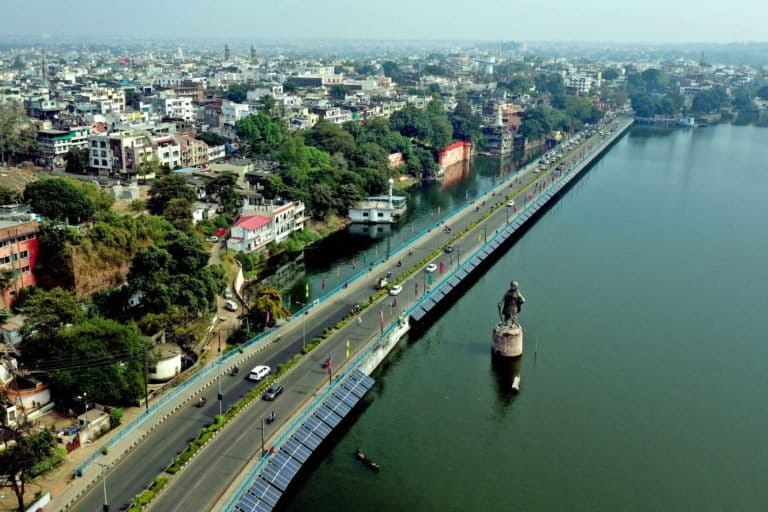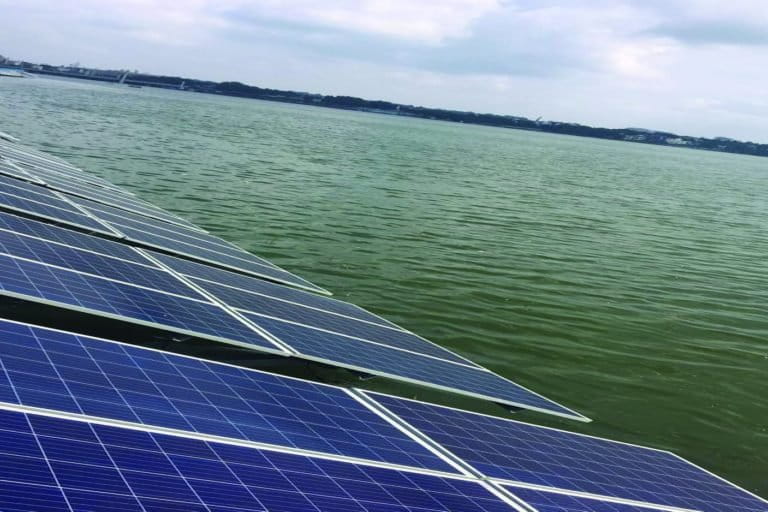
Madhya Pradesh, a major energy centre in India, has several coal projects operating for decades. With 16.4 gigawatts (GW) installed capacity of thermal power, the central Indian state ranks fourth in the country. However, the state is lagging in the installation of renewable power and has achieved less than half of its target set for next year, which it hopes to make up for with large-scale projects.
In 2015, as part of India’s clean energy transition process, the country announced a target of installation capacity of 175 GW of renewable power projects by 2022. Following that, targets for every Indian state were set. Madhya Pradesh’s target was 12 GW of renewable power capacity by 2022.
From 0.03 GW (30 MW) in 2004, the total installed capacity of the renewable power projects in Madhya Pradesh is currently 5.38 GW (5381.19 MW), including 2.6 GW solar (2,633.59 MW) and 2.5 GW (2519.89 MW) wind energy. With this, the state has reached 44 percent of the target of 12 GW by 2022. Now, to fill the deficit of 6.6 GW (6,636.81 MW) and boost the adoption of cleaner sources of energy, the state is relying on setting up some of the largest renewable power projects in India to help take it towards its 2022 targets.

“Madhya Pradesh is planning to produce more than 10 GW from solar energy. The upcoming Shajapur solar park would be the biggest solar park of MP with an installed capacity of 1.5 GW,” said Hardeep Singh Dang, Madhya Pradesh’s Minister for New and Renewable Energy and Environment in a statement. “Apart from this, a 950 megawatt (0.95 GW) park in Chhatarpur and a 1,400 MW (1.4 GW) in Morena are also in the pipeline. These projects would cost Rs. 18,000 crores (Rs. 180 billion) and the total output would be 4,500 MW (4.5 GW) from these solar parks,” he said.
In addition to the large projects, the state government is also focusing on the agriculture sector and has set a target to install 45,000 solar pumps by 2023. So far, 23,500 farmers have registered for the scheme and 6,871 pumps have already been installed. Also, 357 farmers with 2,961 acres of land have expressed their interest in installing solar panels worth 600 MW (0.6 GW) capacity. The government is planning to install 100 MW (0.1 GW) with the help of farmers by in 2021-22.
Madhya Pradesh has a renewable energy potential of about 30 GW, according to government estimates. But, while the state is focusing on large-scale renewable power projects, mainly solar power, other possibly viable options, such as rooftop solar are being ignored. The state has 120.11 MW (0.12 GW) installed capacity of rooftop solar projects (as of August 31, 2021), according to the latest report.
At present, Madhya Pradesh has 25.29 GW of total installed power capacity and, of that, about 21 percent is from the renewable sector.
“As of date, approx. 1.7 GW of renewable projects are under construction, including 0.42 GW of solar, 0.40 GW of wind, and 0.90 GW of hybrid projects. Furthermore, the state has approved 5 GW of solar projects with scheduled commissioning in 2022-23,” Payal Saxena, a renewable energy researcher working with Council on Energy, Environment and Water (CEEW), told Mongabay-India.
According to a CEEW study, Madhya Pradesh ranks the highest for utility-scale projects that could be taken to meet the 5 GW of solar power target by the Indian Railways based on their operations, land availability, and favourable RE policies.
“The state has seen a radical increase in the RE capacity share by eleven-fold since 2012. Central and state government entities, utilities, and international development agencies are making collective efforts to achieve the target in time,” she added.

Manoj Verma, a former senior energy consultant of Madhya Pradesh Energy Development Corporation, had similar sentiments to share.
“With big solar projects, Madhya Pradesh will soon achieve its (2022) target. More solar projects are being installed regularly on a smaller scale like the 750 KW solar plant on Bhopal’s Upper Lake, rooftop plants on college and school buildings,” Verma, who is currently serving as an assistant professor at the Department of Energy at Chhattisgarh’s Swami Vivekanand Technical University, told Mongabay-India.
He, however, said that along with renewable energy-friendly policies, the government agencies need to create awareness about “incentives and assist those who apply for small scale production at the local level.”
“High (initial) investment poses a challenge in developing the renewable sector. The issue of power storage is another challenge for large scale production. The only option is integration with the grid, which involves confusing procedures for normal people,” Verma emphasised.
CEEW’s Saxena, meanwhile, drew attention towards many “land-related complexities” such as encroachment, resettlement requirements, and demands for high compensation which she said, “take time in settling.”
She also highlighted that Madhya Pradesh’s major focus is on solar parks which ultimately impacts the growth of the wind power sector.

“Some of the reasons for this slowdown are stiff tariff competition with solar as most wind-rich sites are already occupied, wind power curtailment during windy season and associated revenue risk, variability issues, windy sites being more concentrated than solar which are more dispersed, and transmission infrastructure-related challenges, lowering down the interest of key players,” Saxena said.
Madhya Pradesh also claims to have discovered one of the lowest per-unit prices of power from renewable projects in the country but that brings its own sets of challenges.
According to official data, the state discovered the lowest tariff of Rs 2.14 per unit (kilowatt/hour) in unit-2 of the Neemuch solar park.
The per-unit tariff from Shajapur solar park was Rs 2.35 and Rs 2.33 for Unit-1 and Unit-2 respectively. While the tariff for Agar solar park was Rs 2.459 and Rs 2.444 for Unit-1 and Unit-2 respectively. Last year, the 750-MW Rewa Solar Project, claimed to be one of the largest single-site solar projects in India, had found a tariff of Rs 2.97 per unit.
Madhya Pradesh’s Chief Minister Shivraj Singh Chouhan, at a recent investor’s meet in Bhopal, attributed the state’s low tariff of Rs. 2.14 per unit of electricity, which he claimed is the lowest in India, to continuous technological advancement.
While India is projecting the lower tariffs discovered in the solar projects as a success, experts are concerned. A December 2020 study by Jyoti Gulia of the JMK Research and Analytics and Vibhuti Garg of the Institute for Energy Economics and Financial Analysis (IEEFA) said that “India is seeing aggressive tariffs for various reasons.”
“Increased interest from new global entrants, availability of low-cost funding, the expectation of falling module prices, and possible adoption of new technology to increase generation are some of the factors driving the tariffs to a new low,” it said.
It cautioned that risks that need to be taken into consideration “before taking such aggressive steps include lesser generation on account of lower radiation than estimated, inadequate operation and maintenance practices, equipment failure, floating interest rates that change in line with the RBI guidelines, rise in module costs due to various global demand and supply factors, currency fluctuation leading to higher prices for imported modules and inverters, power offtake risk of loss-making distribution companies (discoms) and curtailment issues.”
“Project quality might also be impacted or compromised by such aggressive tariffs,” the study held.
Manoj Verma, while talking about other challenges, emphasised on the power producers getting delayed returns and facing state-specific situations “along with hostile policies” that are not encouraging for private investors.

CEEW’s Payal Saxena also noted that uncertainty in policies and regulations is a significant challenge for the state. “An increase of GST rate from 5 percent to 12 percent in solar PV (photovoltaic) projects could be a roadblock. Unavailability or delay of transmission infrastructure in renewable energy concentrated regions could be a hurdle, as we foresee 6 GW renewable energy installations in MP over the next two years,” she said.
Verma, meanwhile, further said, “Weather, climate and geographical location affects power generation when using the renewable energy sources.” He suggested solar-wind hybrid plants for more efficient power generation instead of focusing solely on either wind or solar.
Moreover, with the rapid advancement in technologies, every quarter sees an enhanced version of photovoltaic (PV) modules that are more efficient with competitive module prices.
“This leads to switching to new technology for any projects coming 12-18 months down the line, ultimately impacting initial procurement strategies and design considerations. For instance, the launch of the 670-watt PV module will create more interest as it further reduces the balance of the system (BoS) with improved LCOE,” said Saxena.
Recently, the Chinese PV manufacturer Trina Solar launched a new Vertex solar module with a power output of 670 W. The new product, which features a conversion efficiency of 21.6 percent, was conceived for large scale solar power projects and is the most powerful panel manufactured by the company to date.
Banner image: Roof top solar panels are being installed on government buildings of Madhya Pradesh. Photo courtesy Madhya Pradesh Urja Vikas Nigam Limited.